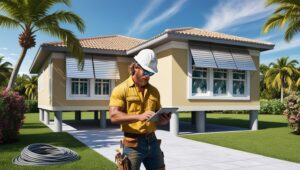
Florida is renowned for its beautiful beaches, warm climate, and vibrant communities, but it is also synonymous with hurricanes. For homebuyers considering purchasing property in a high-velocity hurricane evacuation zone, understanding the risks and taking appropriate precautions are crucial. These zones, often depicted on a hurricane zone map for Florida, are more vulnerable to the severe winds and flooding associated with hurricanes.
In this guide, we’ll cover what it means to live in a high-velocity hurricane zone, the importance of Florida’s hurricane evacuation zones, and how to prepare for the risks that come with homeownership in these areas. We will also delve into key considerations like Florida’s building codes and insurance, to help you make an informed decision.
What is a High-Velocity Hurricane Evacuation Zone?
A high-velocity hurricane zone (HVHZ) refers to regions that are particularly susceptible to intense winds and storm surges. These areas, mostly located along the coast, face the highest risk during a hurricane. In Florida, high-velocity hurricane zones have stricter building codes due to their vulnerability to storms.
The state has implemented stringent building codes in these areas, as defined by the Florida Building Code for high-velocity hurricane zones. This regulation ensures that homes are built to withstand the extreme forces that hurricanes can bring.
Where Are High-Velocity Hurricane Zones Located in Florida?
Using a Florida hurricane zone map or a high-velocity hurricane zone map for Florida, you can identify the areas most at risk. Generally, the Florida high-velocity hurricane zone encompasses coastal regions, including the southern part of the state like Miami-Dade and Broward County.
However, even areas further inland, like Hillsborough County, have designated hurricane evacuation zones due to potential flooding and storm surges.
Why is Knowing the Florida Hurricane Evacuation Zones Important?
Florida has a comprehensive evacuation plan designed to protect residents in the event of a hurricane. Florida hurricane evacuation zones are determined based on factors like elevation, storm surge potential, and proximity to the coast. When buying a home, knowing the hurricane evacuation zones in Florida is critical. It could affect how quickly you need to leave your home and the precautions you must take during a hurricane season.
A Closer Look at Hillsborough County’s Evacuation Zones
Hillsborough County Florida hurricane evacuation zones offer a clear example of how evacuation routes and zones are categorized. These zones are ranked from A to E, with Zone A being the first to evacuate in case of an impending storm. It is highly recommended to consult a map of Florida hurricane zones or a hurricane zones in Florida map to better understand where your potential new home sits in relation to these evacuation routes.
Key Considerations for Buying a Home in a High-Velocity Hurricane Zone
Purchasing a home in a high-velocity hurricane zone requires careful planning and consideration of multiple factors. While living in Florida’s beautiful coastal areas is desirable, it comes with challenges that are essential to understand.
- Building Codes in High-Velocity Hurricane Zones
The Florida Building Code is among the strictest in the country, especially in high-velocity hurricane zones. When purchasing a home in these regions, ensure that the property adheres to the Florida building code for high-velocity hurricane zones.
Key regulations include:
- Impact-resistant windows and doors.
- Reinforced roofing materials.
- Elevated construction to minimize flood damage.
Homes in high-velocity hurricane zones must meet these codes to minimize structural damage during storms. For example, the Florida high-velocity hurricane zone building code mandates that homes are built to withstand wind speeds of up to 170 mph in certain areas.
- Insurance for High-Velocity Hurricane Zones
Insurance premiums for homes in high-velocity hurricane zones tend to be higher due to the increased risk of damage. It’s important to shop around for the best coverage and understand what your policy entails. In many cases, standard homeowners’ insurance does not cover flooding, so purchasing separate flood insurance is often necessary.
Additionally, when buying a home in Florida hurricane zones, check whether the insurance covers wind damage, which is a significant concern during hurricanes.
- Location and Elevation
Location matters significantly when buying a home in Florida hurricane zones. Homes closer to the coast are more susceptible to storm surges and flooding, while those at higher elevations face less risk from water but may still be vulnerable to wind damage.
Check the Florida hurricane zones map and hurricane evacuation zones in Florida to assess the risk level in the area you’re considering. Coastal properties in high-velocity hurricane zones are more likely to require evacuation and face damage during a storm, whereas homes further inland might not be as severely affected.
- Storm Surge and Flooding Risks
Flooding is one of the biggest threats during hurricanes. Homes in hurricane zones for Florida often face significant flooding risks due to storm surges, especially those located in Zone A on a hurricane zone map Florida.
It’s advisable to review FEMA’s flood maps or consult a Florida hurricane zone map to understand the flood risk in your area. Areas designated as high-risk flood zones often require additional preparation and higher insurance premiums.
- Preparing for Evacuation
If you live in a Florida hurricane evacuation zone, understanding when and how to evacuate is essential. Homes located in Zones A and B are the first to be evacuated during a hurricane threat, while those in Zones C, D, and E may have more time. Hurricane evacuation zones Florida are clearly marked, and it is critical to have a plan in place for when a storm is approaching.
Ensure that your home is equipped with an evacuation kit that includes essential documents, medications, water, non-perishable food, and other supplies necessary to sustain your family for several days if needed.
The Pros and Cons of Buying in a High-Velocity Hurricane Zone
There are both advantages and disadvantages to buying a home in high-velocity hurricane zones. Here’s a breakdown to help you weigh your decision:
Pros:
- Access to Coastal Living: Many homes in Florida hurricane zones are situated near the coast, offering scenic views and a desirable lifestyle.
- Resilient Infrastructure: Thanks to the Florida Building Code, homes in these areas are built to higher standards, which may reduce long-term repair costs.
- Potential for Higher Appreciation: Coastal properties often appreciate faster than inland properties, making them a valuable investment.
Cons:
- Higher Insurance Costs: Homes in high-velocity hurricane zones come with higher insurance premiums, especially for wind and flood damage.
- Frequent Evacuations: Living in a hurricane evacuation zone means you may need to evacuate your home several times during hurricane season.
- Potential for Severe Damage: Despite building code improvements, homes in high-velocity hurricane zones remain at risk of severe damage from wind and water.
What to Look for When Viewing Properties in a High-Velocity Hurricane Zone
If you’re considering purchasing a home in a Florida hurricane zone, there are a few key features to look for that will help protect your investment and ensure your safety:
- Impact-Resistant Features
Homes in Florida high-velocity hurricane zones should have impact-resistant windows, doors, and garage doors. These features are designed to withstand the high winds that often accompany hurricanes and can reduce the risk of catastrophic damage to your property.
- Roof and Foundation Quality
Check that the roof is built to meet Florida Building Code standards for hurricane resistance. Metal roofs, for example, tend to hold up better under hurricane conditions. The foundation of the home should also be built to withstand both flooding and high winds.
- Elevation Above Flood Level
Ensure that the home sits above the base flood elevation level as recommended by FEMA. Homes in hurricane zones in Florida that are elevated have a much lower risk of flood damage.
- Hurricane Shutters
Look for homes equipped with hurricane shutters, which are a must-have in high-velocity hurricane zones Florida. These shutters provide an extra layer of protection for windows and doors during a storm.
- Generator and Backup Power
In areas prone to hurricanes, power outages are common. Homes with backup generators or solar power systems with battery storage can provide essential power during extended outages.
Preparing for Hurricane Season
Living in a high-velocity hurricane zone requires a proactive approach to hurricane preparedness. Here are some essential tips to ensure that your home is ready for the next hurricane season:
- Secure Your Property
Make sure that all outdoor items are secured or brought inside during hurricane warnings. Patio furniture, grills, and other outdoor objects can become dangerous projectiles in high winds.
- Install Surge Protection
Power surges caused by hurricanes can damage electronics and appliances. Install a whole-house surge protection system to prevent electrical damage.
- Develop an Evacuation Plan
If you live in a Florida hurricane evacuation zone, you need a clear evacuation plan. Know your evacuation route and have a plan for where you will stay. Keep an emergency kit ready with essential items like food, water, clothing, and medications.
- Prepare for Flooding
Even if your home is not in a flood-prone area, hurricanes can bring unexpected flooding. Elevate important items and documents to a higher level in your home, and ensure that drainage systems around your property are clear.
Final Thoughts on Buying a Home in a High-Velocity Hurricane Zone in Florida
Buying a home in a high-velocity hurricane zone Florida comes with significant risks, but it also offers unique benefits. With the right precautions, including adherence to Florida’s building code, proper insurance, and hurricane preparedness, you can enjoy the beauty of Florida’s coastal areas while minimizing potential damage.
By consulting a Florida hurricane zones map and understanding your hurricane evacuation zones in Florida, you can make an informed decision and be ready for any challenges that arise.
Make sure to work with real estate agents who specialize in these areas and seek the guidance of insurance professionals to ensure that you’re fully prepared for life in a high-velocity hurricane zone.
FAQs
- What is a high-velocity hurricane zone in Florida?
A high-velocity hurricane zone is a region in Florida that is particularly vulnerable to high winds and storm surges from hurricanes. These areas have stricter building codes to help minimize damage during storms. - How do I find out if a property is in a hurricane evacuation zone?
You can check local government websites or consult a hurricane evacuation zone map for Florida to determine whether a property is in an evacuation zone. - What are the insurance requirements for homes in high-velocity hurricane zones?
Homes in high-velocity hurricane zones often require additional insurance coverage for wind and flood damage, which is not typically covered by standard homeowner’s insurance policies. - Are there benefits to buying a home in a hurricane zone?
Yes, coastal homes can appreciate faster, and homes built to the latest Florida Building Code are highly resilient. However, these homes come with higher insurance premiums and potential risks during hurricane season. - What should I do if a hurricane is approaching my home?
Follow local evacuation orders, secure your home, and prepare an emergency kit. Evacuate as directed if you are in a high-risk area.



